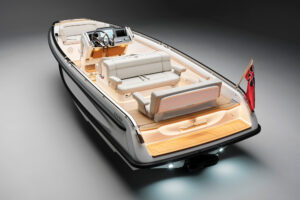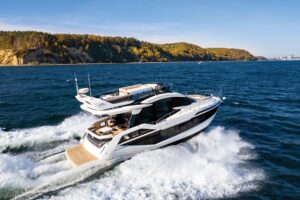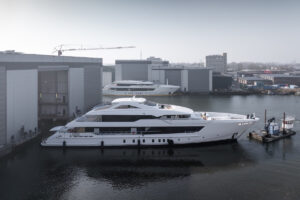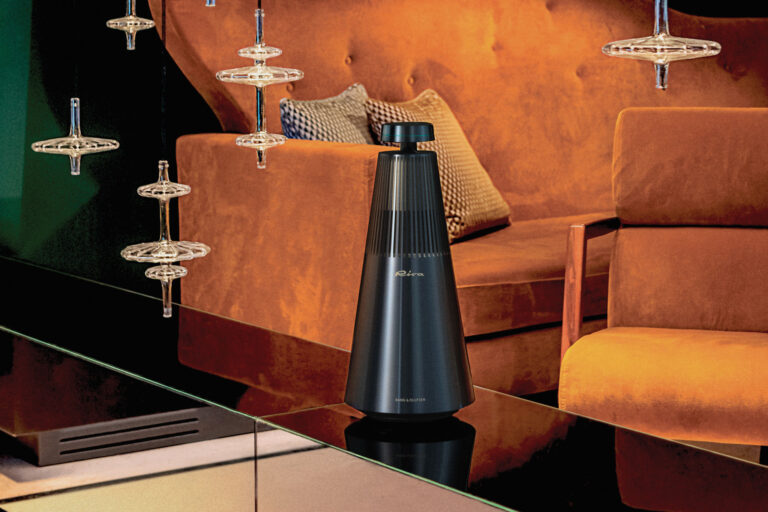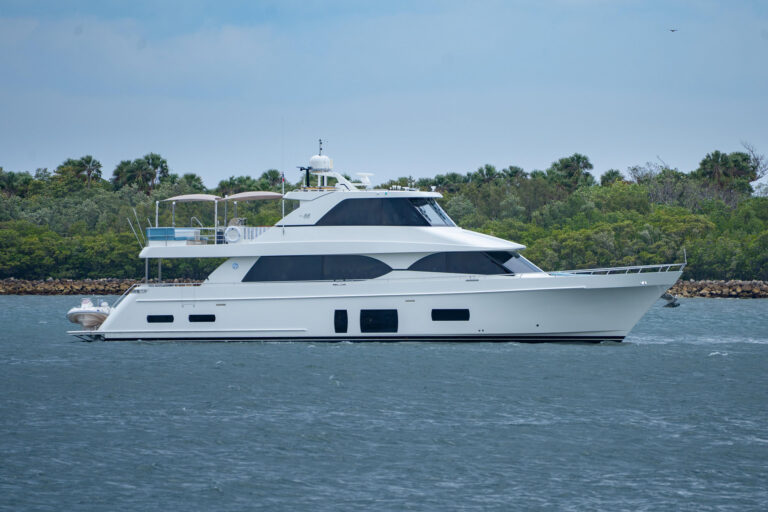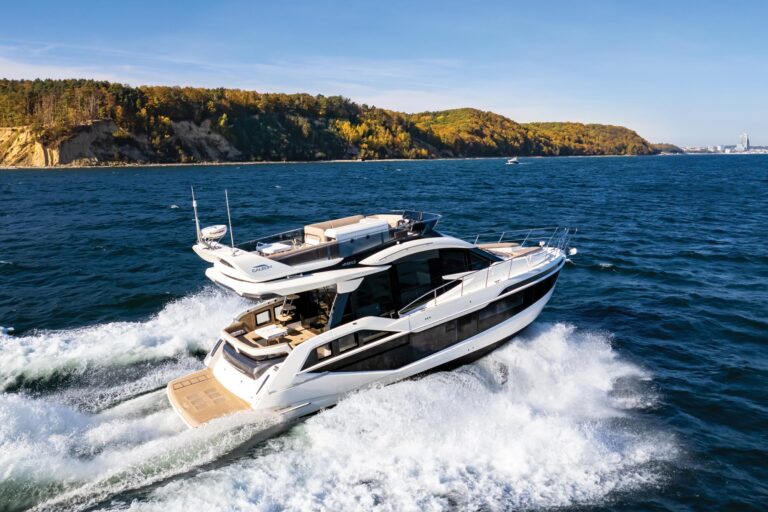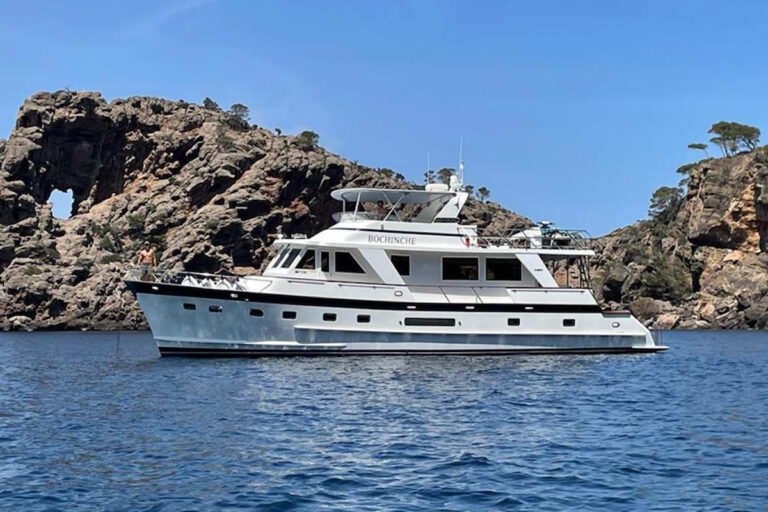Now that we live in an age of full disclosure, I must confess that I was somewhat predisposed towards the Vicem 54 before I ever stepped aboard. A product of pre-fiberglass days, I love that the Vicem’s built of wood, primarily African mahogany, using a technique perfected in the PT boats of World War II. But if I had expected the Vicem to pose a threat to my journalistic standards, I had nothing to worry about. Even without my help, the 54 is a fine yacht, beautifully built in terms of both structure and joinery, with top-grade machinery and equipment. She should satisfy anyone lusting after a prime example of a Down East-style yacht.
Regular readers of YACHTING know that Vicem is a Turkish company, located near Istanbul. (Talk about down East!) Shipwrights have been building rugged boats in the eastern Mediterranean and Black Sea since Noah launched the Ark, so it’s no surprise that 21st century craftsmen maintain the tradition. Nowadays they’re combining old-time woodworking skills with modern resins and adhesives to produce hulls that are light, stiff and strong, every bit the equal of composite hulls. The Vicem 54’s hull comprises four layers of mahogany planking, each oriented at an angle to the one below, bonded together with fasteners and WEST epoxy; the top planking runs fore and aft, although, since it’s covered with a layer of E-glass in epoxy, then faired with epoxy putty and Awlgripped, no one will notice: The Vicem 54’s topsides are smooth and shiny as gelcoat. Knowing that many of their yachts will voyage to hot climates, Vicem buys its mahogany in logs, then mills and dries the wood thoroughly so it won’t change shape, and degrade the surface, after construction.
Unlike boats of conventional plank-on-frame wooden construction, cold-molded hulls are built skin-first over a form; the frames, stringers and other interior hull supports are added later. This is the Vicem method; they then laminate the frames over templates, building them in one piece to run from gunwale to gunwale over the keel. Keel and stringers are solid timbers, and all the structural wood inside the hull is coated with WEST epoxy to seal out water, prevent rot and make it easy to keep clean. In the engineroom, the hull is Awlgripped as well. The test boat’s engineroom was refrigerator-white, so even minor fluid leaks will be easy to locate and repair.
Since Vicem is so adept at laminating wood, I half-expected the 54’s cabin and saloon soles to comprise a veneer of mahogany over something less expensive. But they’re solid, built plank-by-plank with an inlay of iroko in the joints to create a nicely contrasting pattern. The saloon sole lifts for access to the engines, with hatches that are wide enough to remove the diesels if necessary. The teak decks (optional) and cockpit sole are also stick-built, expertly laid out with waterways to facilitate drainage. Interior joinery-mahogany on the test boat but also available in cherry, pear or rosewood-is flawless, the equal of any boatbuilder east or west of the Bosphorous. Vicem craftsmen start young, learn by apprenticeship, then remain with the company; it’s common for a 35-year-old carpenter to have more than 20 years on the job. The result is high-quality work throughout, by folks who are obviously proud of what they create.
Layout is typical, with a plush saloon in the deckhouse, and a galley, dinette and two staterooms below; an optional layout moves the galley into the deckhouse and adds a third cabin below. The galley in the standard plan is spacious enough to prepare a proper meal, and comes with a combo microwave/conventional oven, full-size refrigerator and a four-burner electric cook-top. A freezer and granite countertop are optional; the test boat had both. The uncluttered counter between the galley and dinette makes it simple to shift prepared food from stove to table, with no carrying of platters or serving dishes. Anything spilled will be easy to clean up; the test boat’s dinette was upholstered in harem-soft leather; as was the saloon, including the helm seat. (Fabrics are standard.)
The master cabin is forward, guest cabin, with twin berths, to starboard. Each cabin has its own head, but the two share a shower; a painless way to save space while minimizing both complexity of systems and expense. The volume regained by dispensing with the second shower is split between the heads, so both are roomy enough for even potentate-sized folks. In the event two crew members get the urge to shower simultaneously, there’s room for them to do it together.
The deckhouse has the helm station and chart table forward, settee with table, easy chairs and entertainment center aft. On the test boat, a Sharp Aquos flat-screen television (one of three aboard) rose silently from the entertainment cabinet at the touch of a switch, while one chair contained a discreet liquor locker under its cushion. My two minor gripes with the Vicem 54 do come from this area: Given the boat’s 16-foot, 6-inch beam, I’d want an overhead grab rail running along the centerline for more security in rough weather-the saloon is too wide to rely on grabbing furniture for personal stability. I’d also raise the helm seat a bit: I’m nearly 6 feet tall, but had to sit on an extra cushion to get what I consider a proper sightline from the helm at cruising speed. This problem is common aboard Down East-style boats, where the helm stations are low and relatively far aft, so a bit of bow rise at speed causes some obstruction. But there’s also an easy, inexpensive fix, as long as the builder is notified, and it should be even easier at Vicem, where no fiberglass molds are involved. I didn’t see the flying bridge option, but if the design is cleverly done it might even improve the boat’s classic profile. It’s certainly worth consideration, even at $62,000. The Vicem 54’s price, around $1 million, includes lots of standard equipment (even radar, autopilot and pro-quality chart plotter), yet is roughly half that of similar boats from the best domestic builders, so buyers have room to play.
There’s plenty of seating in the cockpit, along with a wet bar which, on the test boat, incorporated a grill and refrigerator, too. For in-water recreation, the Vicem 54 sports a wide swim platform reached via a sturdy transom door. Access to the lazarette is through a hatch in the teak cockpit sole: The generator, batteries, air conditioner and lesser gear live down here; the test boat also had a combo washer/dryer. A watertight door in the lazarette’s forward bulkhead leads to the engineroom; it’s a crawl-in situation, but once inside there’s plenty of room to carry out daily engine checks, clean filters and strainers, and so forth. You just have to do it on your knees. (For major engine work, remove the saloon sole.)
The bottom line on the Vicem 54? It’s a first-class yacht built to standards that take a back seat to nobody, but at a price that won’t send you heading for the hookah. While I love the cold-molded construction, I think most buyers will fall first for the elegance of design, joinery and finish. With a company this happy and proud of its craftsmanship, you should be happy aboard a Vicem 54.
Contact: Down East Yachts, (631) 418-2700; www.deyachts.com.

